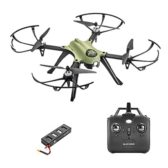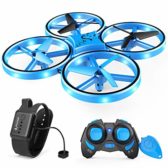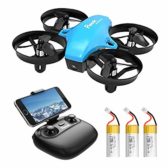The Best Drones Without a Camera in 2021
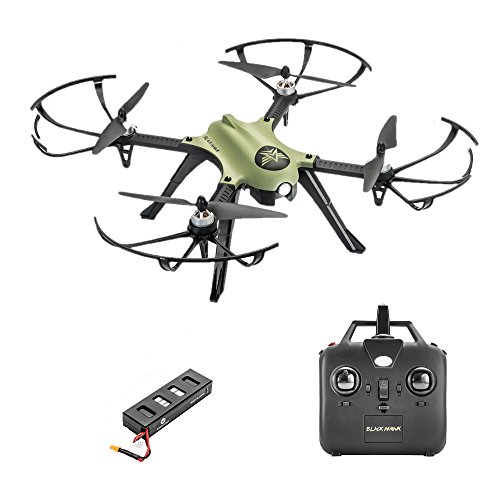
Altair Aerial Blackhawk
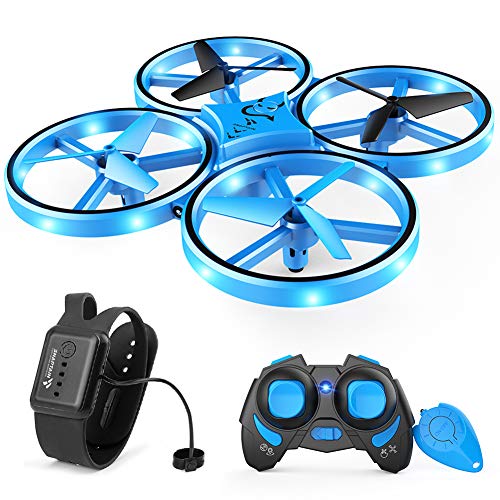
SNAPTAIN SP300
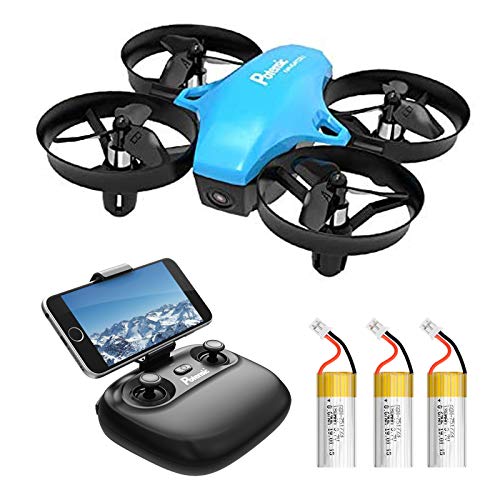
Potensic A30 Mini
Drones have evolved from simple flying contraptions to the smart devices they are today. Nowadays, they are fitted with everything from GPS to obstacle avoidance.
But there’s a beautiful simplicity with drones that are pared down to the basics. It makes you focus on what actually makes drones so great – flying.
Today, we look at one such class of drones; those that don’t have a camera built-in. We’ll look at the many reasons why you’d want to get one, and what other features you should look into when searching for the best drone without a camera.
The Best Drones Without a Camera
We may receive compensation on qualifying purchases via our links. This does not change how we review items. For more information, please read our affiliate disclosure.
This is a mid-level drone that’s as speedy as its durable, with a budget price to boot!

- Flight Time: 15 – 17 minutes
- Range: 500 meters
- Supported GoPro models: Hero 3 and 4
The Altair Aerial Blackhawk looks just like any other toy drone…
But unlike most drones in its price range, the Blackhawk is made of a full metal body, making it extremely hardy. It’s able to withstand heavy crashes and bumps, and yet is lightweight enough to zip and fly around like a boss.
And can this drone fly thanks to its 6-axis gyro. The Blackhawk is pretty easy to control and is reasonably responsive that you can perform agile maneuvers without much effort. The Blackhawk also stable in the air and can hover despite moderate winds – a side effect of the added heft of its all-metal body.
The Blackhawk is also pretty fast, which can be adjusted via speed controls if you want a much slower flying experience. The flight time is 15 minutes on average, which is pretty long for a drone of its caliber. The 500 meter range also gives you considerable freedom on how far you can fly this drone without the signal breaking down.
There are no significant flight features on the Blackhawk, not even Altitude Hold. This isn’t necessarily a bad thing – in fact, the lack of these features allow you to fully control the drone, letting it rip through the air as you please. It’s manual flying at its finest.
Of course, this lack of supporting flight features might be a turn-off for some newbies. While it can still be a beginner drone, other models in the market are easier to learn from.
Finally, the Blackhawk also functions as a GoPro drone. The mount allows you to attach the Hero 3 o 4 camera, or really any action camera as long as it fits, should you want to have photo and video capabilities in the future.
All in all, the Blackhawk is a mid-level drone that gives you the thrill and fun of flying. It might lack advanced features of other drones, but it makes it up with maneuverability and durability.
+ Pros
- Cons
No products found.
If you could ever describe an advanced toy drone, the Snaptain SP300 might fit that exact description.

- Flight Time: 8 minutes
- Range: 50m
- Weight: 72g
What makes this drone particularly innovative is in the many cool ways you can fly it.
Let’s start with the most excellent way: hand activation. The SP300 can be flown entirely by hand. No, really!
This is done via infrared sensors around the drone, which can detect your hands. You can simply “push” it, and the drone will move accordingly. Launching the drone by hand is also possible simply by tossing it in the air. Very cool and great for little kids to play with.
By the way, these same sensors essentially give the SP300 omnidirectional obstacle avoidance. It will generally steer clear and push itself away from obstacles. For a budget toy drone, this is amazing!
Now, let’s explore controlling the drone with the three (yes, three!) controllers provided. These many options on how to fly the SP300 is what actually makes it fun to operate.
First, the small mini remote is simple enough – the one button it has is for launching and landing the drone.
The second controller is your traditional joystick controller, perfect for those who already have drone flying experience.
The last controller is also the most interesting. It’s the G-Sensor hand controller, and attaches to your wrist and finger, and involves you controlling the SP300 with finger movements. There really is no way to describe it, so it’s best you try it out yourself.
The other features and specs of the SP300 are pretty basic. LED lights are cool and make for great flying at night. The 3D flips are standard, as is the 8 minute flight time.
At its core, the Snaptain SP300 is simply a durable and lightweight drone. But what makes it unique are the many fun ways you can fly it that makes it the best toy drone for kids, in our opinion.
No products found.
No products found.
The A30 Mini is a speedy and durable flyer that makes a great intro to drone flying.

- Flight Time: ~7 minutes
- Charge Time: ~75 minutes
- Range: 15m / 60ft
- Remote Controller: WiFi 2.4Ghz (included in the set)
- Camera: N/A
- Live Video Transmission Range: N/A
- Weight: 318g / 11.2oz
- Working Temperature: 5°C to ~ 40°C
- Rated for indoor and outdoor use
The Potensic A30 is a toy drone with a very distinct looking frame that will instantly appeal to older kids.
The sleek yet colorful exterior looks cool but is more than just for aesthetics. It’s actually pretty durable and does a great job of protecting the insides of the A30. The propellers also have a natural shell that shields them from impact. It can confidently survive crashes with minimal or zero damage.
Performance-wise, the A30 is very easy to fly. It’s agile and responsive and can change directions almost instantly. It’s fast as well, with three adjustable speeds to suit any skill level.
Compared to most toy drones, however, the A30 has some flight features of many mid-level adult drones. One is Altitude Hold. Thanks to the built-in barometer, it can pretty much stably hover in place even with the hands off the controller.
It also supports One Touch Takeoff/Landing and Headless Mode, which makes flying the A30 very effortless even for children with no experience.
The A30’s flight time is at around 8 minutes, which about average as toy drones go.
The Potensic A30 is, in our mind, the perfect introduction drone for newcomers to the hobby. More than just a toy, it can teach older kids or newbie pilots how to properly fly a drone before moving on to more advanced models.
+ Pros
- Cons
No products found.
The Holy Stone HS150 Bolt Bee is a fun and zippy little flyer that’s great to have if you want to get into drone racing.
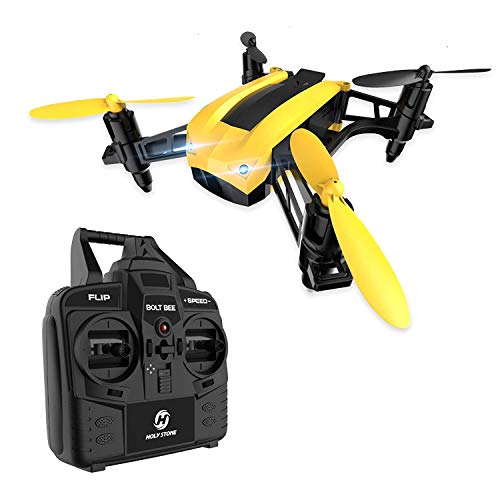
- Flight Time: 5-7 minutes
- Range: 100 meters
- Top Speed: 50 km/hour
- Camera: None
- Weight: 68g
This drone is all about speed. It’s capable of topping speeds of up to 50 km/h, which is enough to give you a rush while flying this drone. While it’s not fast enough to beat a decked out racing drone, it still makes for a good practice racer.
But if you want to just play this drone around at slower speeds, you can, too. The Bolt Bee has five-speed modes that allow you to fine-tune how fast you want this drone to run around.
Despite the speed, the HS150 is fortunately easy to fly. The physical controller has a traditional joystick layout, and they’re all very responsive. One tap instantly sends the Bolt Bee flying in the right direction, and avoiding obstacles is a breeze.
The drone does lack some flight features like Altitude Hold, which makes hovering in place a challenge. But that’s okay since staying put isn’t what the Bolt Bee was built to do. The drone DOES have a 6-axis gyro, which gives it decent stability while flying around.
Construction-wise, the Bolt Bee is solid. Its smaller and lighter frame means impacts aren’t as substantial and damaging as a full-sized drone. The rigid body doesn’t that have many moving parts, and that helps as well.
The 10 minutes recommended cooldown in between flights is the only thing we would slightly complain about it. While it’s necessary to prolong its life, we have to admit it ruins the momentum.
But other than that, the Holy Stone HS150 Bolt Bee is a fun drone to fly. It’s a dirt cheap, zippy, and fast drone that’s easy to operate. What’s not to like?
+ Pros
- Cons
The Goolsky JJRC H31 is fun to fly and splash drone. It’s the perfect drone to take to your next beach trip or simply down by the pool.
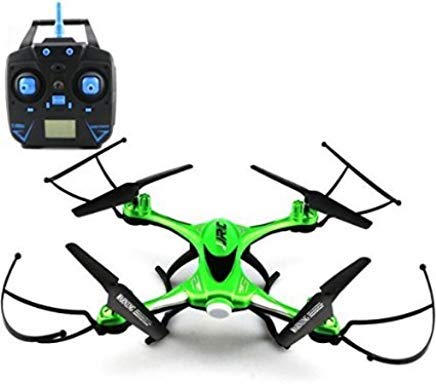
- Flight Time: ~8 minutes
- Charge Time: ~60 minutes
- Range: 70m / 230ft
- Remote Controller: 4C radio controller (included)
- Camera: No Camera
- Live Video Transmission Range: N/A
- Weight: 64g / 2.2oz
- Carry Capacity: N/A
- Working Temperature: 6°C ~ 40°C
- Rated for outdoor use
Flying your drone around a body of water is generally a terrible idea; even the moisture spray from the sea will wreak havoc on any drone’s internal circuitry.
Except, of course, when you’re flying the JJRC H31. This is one of the few (maybe the only) waterproof budget drones you’ll ever come across.
Let’s start with this drone’s best feature. The JJRC H31’s able to withstand being in the rain, intense storms, or even accidentally landing in water. It’s perfect for having a child play around with it since you’ll be comforted by the fact that it won’t get ruined when it touches moisture.
However, do keep in mind that the drone will NOT survive being submerged in water. If it lands on a body of water, it’s best to get it out immediately.
The drone is pretty durable as well on its own, and can survive a crash or two.
The JJRC H31 is very agile and flies quite fast. Operating it is easy for beginners, thanks to Headless Mode. With it, you don’t need to know the orientation of the drone to be able to steer it.
The drone has a flight time of around 8 minutes, with an effective range of 80m. Pretty average specs when it comes to budget drones, but should be enough to give you some fun with it.
The JJRC H31 has limited features aside from being waterproof, but chief among them is its One Key Return function. It’s similar to Return to Home, but since there’s no GPS on board, it’s not as accurate. Still, it gets the job done.
You also have basics covered like LED lights and some flips and stunts.
However, flight stability is one area where the JJRC H31 might have trouble. It relies on its 6-axis internal gyros to keep it stable; however, moderate winds can knock it off its position.
+ Pros
- Cons
The 3DR Solo Quadcopter is one smartest Go Pro ready drones in the world. Maybe it has something to do with the twin 1 GHz processors built into the drone, which essentially makes the drone a mini flying computer.
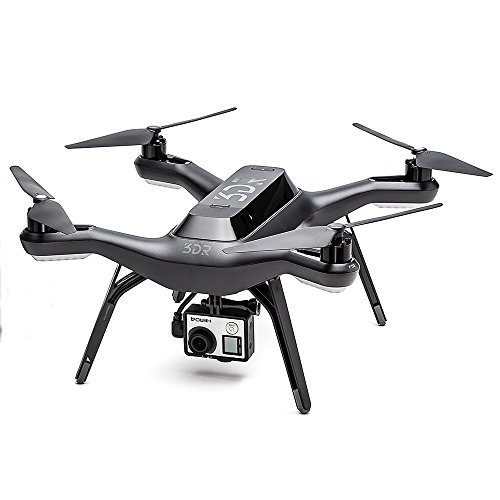
- Follow Me Method: GPS
- Flight Time: 20 minutes
- Camera: none; supports mounting of a Go Pro camera
- Weight: 3.3 pounds
The “brain” of the 3DR is there to power the drone’s many intelligent features. Most of these involve the tight integration of the drone with the Go Pro camera. It essentially allows you to control the camera from mid-air, making FPV, and doing adjustments possible.
Aside from Go Pro integration, you also get plenty of smart flight features from the 3DR Solo. The drone supports push-button flight, which makes it possible to launch the drone or make it stop mid-air at the push of a button.
With a camera equipped, you’ll also get access to features like Follow Me, which makes the Solo track you automatically via GPS. Orbit, Cable Cam, and Selfie also make hands-free operation easy.
But even without a camera, the Solo is a solid and fun drone to fly. The video game-style controller will instantly feel familiar to gamers and kids and makes flying this drone pretty intuitive. It’s just like playing a game.
The flight time of the Solo is also quite long at 20 minutes, giving you a lot more time to enjoy this drone.
However, if you’re solely buying the drone just to fly it, it can be expensive. The full potential of this drone is unlocked only when a camera is equipped.
Nevertheless, the 3DR Solo is indeed a smart drone. It has plenty of intelligent flight modes that make this drone a joy to fly even for complete novices.
+ Pros
- Cons
No products found.
The Syma X5A-1 is a capable drone which you’ll have fun flying well until you reach intermediate skill levels.
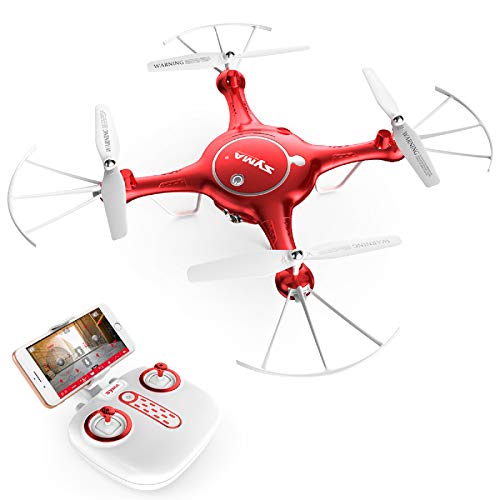
- Flight Time: 7 minutes
- Range: 50m
- Weight: 72g
If you don’t fancy practicing around with a toy drone, then the Syma X5A-1 might be right your alley. It certainly looks more like an adult drone more than what your kid will play with.
As far as specs go, the X5A-1 is pretty basic. It’s capable of flight times of 7 minutes, which is more or less expected out of a beginner drone. The 50m range is appropriate as well for the recommend close-by distances newbie pilots should adhere to.
Flying the X5A-1 is a fun experience. The internal 6-axis gyro gives it excellent stability, which makes turning around and hovering feel “right” and not wobbly. It flies at a decent pace and feels responsive enough, probably due to the 2.4 GHz controller.
The outer body is a rigid and environmentally-friendly plastic material, which gives it some heft and definition. It’s not that fragile that it will quickly succumb to minor crashes.
Since this is a beginner drone, the features are pretty much limited, but they’re nonetheless essential. One of them is a failsafe feature, which automatically initiates a slow descent if the battery becomes critically low. The other one is Headless Mode, which is always a welcome feature in starter drones.
While it’s basic, the drone is far from ineffective.
+ Pros
- Cons
No products found.
The Mysterystone Bugs 3 is a reliable camera-less drone that can go farther and fly longer compared to similarly-priced competitors.
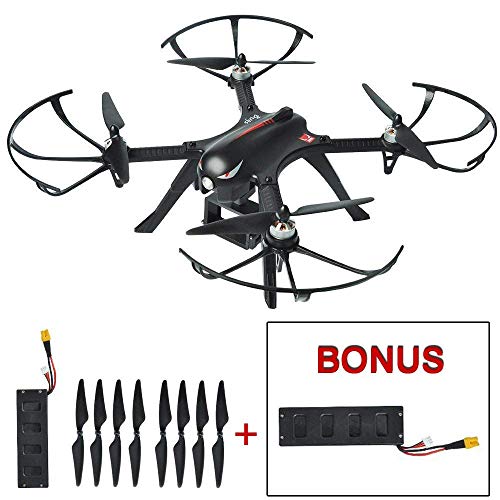
- Flight Time: 16 minutes
- Range: 500m
One of its standout specs is the range. At 500m, it’s undoubtedly lengthy compared to the average of just 50m. This allows you to fly it out a little bit farther than usual. It also means the transmission strength of this drone is excellent at shorter distances, which results in responsive flying.
The flight time of 16 minutes is also something to commend about. The great thing is that a spare battery is included with the package, which effectively extends it to over 30 minutes of flight time with minimal interruption in between.
The standard brushless motors Bugs 3 drones are known for are also present in the Mysterystone, at four 1,000 kV MT1806. It provides excellent lifting power and ample resistant against strong winds. It’s agile and nimble, and overall flies great.
The Mysterystone Bugs 3 has decent durability, which is expected for drones of its class. However, the great thing with this drone is that the package includes two sets of extra propellers, for a total of 8. Talk about an insurance policy!
Safety-wise, it doesn’t have anything automatic like Return to Home or Auto Descend. What it does have is a Low Power Indicator and an Over-Distance Alarm, which alerts you so you can maneuver your drone back safely on the ground.
Finally, the camera mount gives you the option to attach a camera, should you need to do so in the future. Compatible with Go Pro Hero 3 and 4, or SJ4000 and 7000 action cameras.
So if you want to fly a camera-less drone with a little more power and range, the Mysterystone Bugs 3 is a superb choice. It combines raw flight performance with an affordable below-$100 price tag.
+ Pros
- Cons
Why Get A Drone Without A Camera?
One might ask: “why would you want a drone without a camera?”
The answer is that it allows you to focus more on flying, which is actually the primary source of fun with drones. You’re not bogged down by having to frame the right shots or picking the perfect angle. You’re just there to fly. Now that’s freedom!
Aside from that, though, there are lots of practical benefits camera-less drones can give:
They’re often more durable
You know how older mobile phones are known to be more sturdy than today’s more fragile smartphones? Drones kind of follows the same logic.
Drones without cameras often feature fewer internal parts, and can, therefore, be reduced in size and weight. Manufacturers can put more focus on their outer shells, which is often made of hard reinforced plastic or even a full metal body.
This makes these drones ironically more durable. Most of these can survive even the most catastrophic crashes pretty well. This is perfect since most of these drones don’t have any advanced obstacle avoidance or safety features, making collisions much more inevitable.
They have better flight times
The drone’s flight has the biggest drain on its battery, but cameras consume significant amounts of power as well. By removing the camera component, more of the energy is channeled towards flying the drone.
This has the effect of extending the drone’s flight time. Granted, it’s not a big jump, but a few added minutes makes all the difference in the world when it comes to battery life.
They’re more agile
Without cameras bogging them down, camera-less drones are much more agile and fast. This is because more focus is put on their flight prowess and performance, not to mention they’re lighter.
For newbie pilots wanting to practice with a drone, this is the ideal way to do it. You don’t really have any need for a camera while learning the ropes, do you?
They’re lighter
A camera’s lens and internal components all have weight. Once removed, they can significantly lighten a drone, which improves agility and flight time. But more than performance, a lighter drone has a hidden benefit – you often don’t need to register them.
For most countries like the US, drones that are above a certain weight need to be registered with the proper authorities. While it’s easy to do so, it’s still an extra step. Lighter camera-less drones don’t fall in this category. This means you can get to fly them right away without having to worry about legalities.
They’re less expensive
Today’s camera technology has evolved to the point that they don’t really cost that much anymore (just look at how even cheap phones have cameras nowadays). But the fact remains that cameras still have an effect on a drone’s overall cost.
That’s why drones with no cameras built-in are generally less expensive than their photo drone brothers. It’s also much more economical this way. After all, if you’re just buying a drone for the fun of flying, then you shouldn’t pay for a feature that you won’t be using.
They offer better camera options
Okay, this might seem confusing. How could a drone without a camera offer better camera options?
Well, a lot of these drones DO offer options for mounting an external action camera. The good thing about this is that you can choose that camera independently of the drone. This means you can go for a really cheap drone, and still be able to get a top-of-the-line, high-resolution camera to mount on it, like a Go Pro.
Plus, you can freely swap this when a newer camera comes out in the future. And of course, whenever you don’t need the camera, you can just remove it. You still get the benefits of flight time and agility without that extra weight bogging you down.
If that’s not flexibility, we don’t know what is.
What Features Are Available in Camera-Less Drones?
While cameras represent a big chunk of a drone’s functions, the fact is that there are still many features you can enjoy with camera-less drones.
Whenever you’re out buying a drone to practice flying on, consider these features and specs.
Flight Stability
Since you’re mostly going to fly your drone, it needs to have exceptional flight performance. It has to be agile and fast, and feel “right” whenever you’re controlling it.
The controls also need to be responsive as well. If there’s a detectable lag from the time you push a button to the time the drone moves, then it will make flying that much more difficult.
Some drones would also have some stability features, like Altitude Hold. Since most camera-less drones don’t have GPS on board, this is achieved through an internal gyro. This helps the drone orient and hover itself in place. While not as robust as a GPS Altitude Hold, it does the job reasonably well in most cases.
Having an auto hover feature like this can help you fly the drone that much easier. You don’t have to worry about manually maintaining a drone’s altitude, which can get tedious. You can just focus on flying.
Sometimes this stability feature is missing, most notably in racing drones. This is actually an acceptable trade-off since these drones are designed to zip around anyway as opposed to hovering in place.
Extra Propellers
This is a feature mostly present in beginner drones, but often pop up in camera-less drones as well.
Out of all the parts of a drone, the propellers are often the most fragile. Since they’re moving parts, they’re susceptible to becoming dislodged or accidentally removed if ever they crash on to something.
The problem with propellers is that drones need all of them to keep working. If just one of them breaks down, your drone won’t be able to fly properly. That’s why having spares on hand is crucial.
Ideally, look for propellers that are easy to take off and replace. You should also have a minimum of four spare rotors, one for each propeller in a quad.
If your drone doesn’t have or allows swapping propellers, then you need to be much more careful when flying it. In cases like this, you might be better off installing propeller guards to give your rotors some added protection.
Headless Mode
For complete beginners who want to fly a drone right away, Headless Mode is an essential feature to have. And since there is no camera to talk about, orientation is less of an issue with these drones.
Let me explain.
When you’re flying a drone, orientation matters. You need to know the “head” of your drone. This is because when a drone turns, it does so based on its own orientation, i.e., where it’s facing.
This can be confusing for beginners. Let’s say the drone is facing you. If you turn “right” on the controller joystick, the drone will turn right based on where it’s facing, which is to your left!
Drones with no cameras complicate this even further. Since the side with the camera is usually the drone’s “head,” it’s hard to tell which side it is without the camera! This is the #1 cause of crashes among amateur pilots.
Headless Mode eliminates all of this headache (excuse the pun). Now, when you turn right on your joystick, the drone will always turn right based on YOUR orientation, regardless of where it is faced.
Technically, since camera-less drones have no head to speak of, you can leave Headless Mode turned on all the time. And it’s a perfectly acceptable way to fly these drones.
One-Touch Flips and Stunts
To add a bit of flair to your flying, most camera-less and toy drones offer one-touch buttons that allow them to perform amazing 3D flips and other aerial stunts.
It’s undoubtedly a fantastic way to impress your friends. They look convincing enough that people might think you’re skilled enough to pull it off. Just don’t mention that all it takes is a simple push of a button!
Flight Time
Flight time is that one thing that unites all kinds of drones, including those without cameras. Many owners consider it THE spec to look for.
How long your drone remains in the air is a function of its battery capacity. The bigger the capacity, the more energy it has to feed the motors that drive the propellers to turn.
Because they have no cameras to speak of, you’d expect these drones to have a relatively long flight time. Some do fly at a decent time of around 15 minutes, which is generous enough length.
On average, though, expect a flight time of around 5 – 10 minutes for most drones in this category. That’s because since they’re smaller, so are their batteries.
If you want to improve your flight time, consider getting a drone that has a removable battery. This allows you to bring in spares to swap in if the current one is running low. If not, then you’ll have to wait for the drone battery to charge, which can ruin the momentum.
Range
Range defines how powerful your remote controller’s transmission is, and therefore how far the drone can fly out before losing signal.
In camera-less drones, the distance you can fly your drone is actually less of a concern. This is because it’s recommended that you always have a line of sight with your drone. After all, since you don’t have a camera, you don’t have access to First Person View (FPV) mode necessary to assist you in long-range flights.
But the range for camera-less drones is vital for one thing – signal strength. The longer the range, the better the signal your controller has over shorter distances. This can make your drone much more responsive and, therefore, easier to control.
Adjustable Speed Modes
Flying fast is always one fun thing about drones. Zipping a small flyer in circles around the air never really grows old. Also, if you’re planning to go into drone racing, then you need a speedy drone to practice on.
On average, camera-less drones have top speeds of around 50 km/h. This is enough to give you an excellent racing experience, but not really sufficient to reach standard racing speeds, which can clock in at 100 km/h and more. And that’s perfectly fine.
Drones will always have some way of adjusting the speed. That way, you can throttle it down when you want just to fly casually, or when you’re just starting out. This is because faster speeds are harder to control. It also lets you ramp up the speed as you gain more flight experience.
Optional Camera Mount
Getting a drone without a camera doesn’t mean that you’ll go with it forever. If you think there’s a small chance you’d want to take photos in the future, do get a drone with a camera mount.
The mount gives you the option of installing an external camera on your drone when you decide to. Most drones accept Go Pro cameras as default since they’re pretty much the industry standard when it comes to action cameras.
Some advanced drones even offer a way to control the external camera via the drone, making it work seamlessly as one unit.
LED Lights
Flashy LED lights are always a welcome addition to any drone. Some toy drones have this feature, as they can be a great draw for children.
But lights offer more than just entertainment value. They also allow you to fly your drone at night safely. It provides ample illumination for you to see where you’re piloting your drone to.
More importantly, they also alert other people of your drone’s presence, so they can avoid it when needed.
Waterproof
For added durability and insurance, it’s great to have a drone that can withstand a light drizzle or a small splash of water.
Admittedly, this is a feature that’s not too common in drones. Heck, not even the majority of mid to high-end drones are waterproof. But you’d be surprised to know that a select few budget drones actually are (we feature one later in our recommendations section!)
Take note that when a drone is referred to as waterproof, it’s most likely water-resistant. That means they can withstand a splash, but will not survive if you completely submerged them. So, don’t even try it, or you’ll end up with a useless piece of junk!

